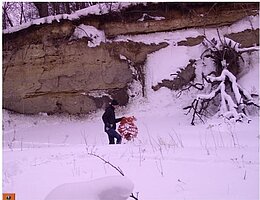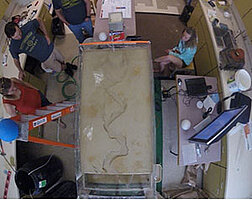Holocene Palaeoflood and Glacial Isostatic Adjustment (GIA) Influence on Fluvial Geomorphology of the Red River Basin

Zachary Phillips is a Ph.D student in the Environmental and Conservation Sciences Program and Geosciences Department at North Dakota State University. He holds a B.S. in Geological Sciences from Ohio State University studying earthquakes in Ohio and a M.S. in Geoenvironmental Studies from Shippensburg University studying fluvial response to dam removals and river restoration methods. His present research topic regards the Holocene erosion of post-glacial rivers (i.e the Red River and the Minnesota River) that are impacted by Glacial Isostatic Adjustments (GIA). The focus of this research is to better understand and model river erosion over the Holocene given the climate and GIA history of the region and develop methods for improving the study of rivers using high-precision remote sensing data as to support conservation, water resource management, and river restoration efforts.
Email: Zachary.Phillips@ndsu.edu
Phone: 513-280-1349
Fellow: Zachary Phillips
Advisor: Stephanie Day, Ph.D., Assistant Professor, Department of Geosciences, North Dakota State University
Degree Progress: Ph.D. in Environmental Conservation Sciences expected in Spring 2020
Holocene Palaeoflood and Glacial Isostatic Adjustment (GIA) Influence on Fluvial Geomorphology of the Red River Basin
My research studies the responses of post-glacial rivers to climate change, post-Glacial Isostatic Adjustments (GIA), changing sediment characteristics, and human impacts using the Red River and Minnesota Rivers as case studies. I use interdisciplinary methods of interpreting fluvial systems and deposits as they correlate to the Holocene and late-Pleistocene history. This fellowship year, I analyzed the Red River’s floodplain topography using Geographic Information Systems (GIS) and developed a set of methods to extract areas of meander-cutoff topography from the Digital Elevation Model (DEM). I used the spatial distribution of the meander-cutoffs, as well as their relief and distance from the modern channel (DMC), as interpretive tools to suggest how meandering of the Red River has changed since the draining of Lake Agassiz. Result reporting is currently being conducted for this portion of my PhD project (Phillips and Day, 2018).
Currently, a Landscape Evolution Model (LEM) is being designed and assembled for the Red River Basin, with a focus on the evolution of the meandering path of the Red River as the basin has slowly tilted over time due to GIA. The LEM is being developed using the python-based LandLab modelling package, which will be used to simulate climate, hydrology, and geomorphology of the Red River Basin.
Significance:
This research is significant because it helps people understand the modern effects of climate change and its interactions with rivers and humans. More specifically, regarding the Red River, this research is important because the Red River is a unique, clay-controlled meandering river which is both important and damaging to its floodplain residents. Being geomorphically clay-controlled because the Red River Valley used to be the bed of Lake Agassiz, the Red River does not meander freely like typical rivers, and signs of modern river erosion are limited to two 20-km reaches centered over glacial moraines deposited during the final retreat of the Des Moines Lobe of the Laurentide Ice Sheet northward through the Red River Valley.
Research Outcomes:
Phillips, Z.R. and S.S. Day, 2018. Exploring and interpreting the distribution of meander-cutoffs of the post-glaciolacustrine Red River of the North, (in submission to the) Journal of Earth Surfaces Processes and Landforms
Phillips, Z.R., 2017. Geomorphometry and spatial analyses as assistants in interpreting fluvial geomorphology, invited speaker to NDSU Introduction to GIS “speaker-week”, Dec. 2017
Phillips, Z.R., 2017. Explaining the possible geomorphic implications of the spatial distribution of meander-cutoffs for the Red River of the North, Geological Society of America Annual Conference, Seattle WA, Oct. 2017
Phillips, Z.R., 2017. Is your meandering river stable? Methods for determining controls of historic river meandering, 2017 Upper Midwest Stream Restoration Symposium, La Crosse, WI, Feb. 2017
Phillips, Z.R., 2016. Investigation of Post-glacial Fluvial Geomorphology and River Valley Growth: a case study of the Red River basin, ECS Greenbag Seminar Research Proposal Talk


Stephanie Day
Geosciences
Office: Stevens 228
Telephone: 701-231-8837
Email: stephanie.day@ndsu.edu


